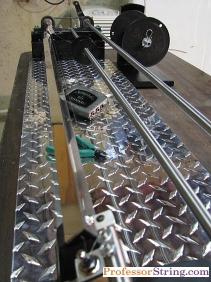
by Professor String


by Professor String |
Handcrafted Guitar Strings: A Secret? |
|
What comes to mind when you hear about guitar and bass strings made by hand?
To most folks, it conjures up images of somebody holding some wires together in one hand, while trying to wind them together with a pair of pliers in the other hand. In reality, that's not how handcrafted strings are produced. Notice we are using the word "handcrafted" versus "handmade" in that previous sentence? There are some string makers who mass produce strings, while still claiming to make "handmade" strings. They are being clever with their marketing, and a bit deceptive. Common sense will tell you it is physically impossible to mass produce 7,000 strings a day using a handful of workers wrapping wire around wire with sets of pliers. In fact, their hands would probably fall off after a few hours of that disastrous winding technique. Even with the usage of Chinese labor at $0.12 an hour, it is a challenging endeavor. In addition, loading an automated wire winder by hand, and pushing a button, does not represent a "handmade" string (LOL!). As a smart consumer and musician, you know better. To get away from the misguided term "handmade", we will use the term "handcrafted". For purposes of this article, handcrafted represents a string manually created by hand.
Is it actually possible to make handcrafted strings?
The short answer is: Yes.
Can they be made in high enough quantities for everyone to afford? Maybe.
Now here is the BIG question...
What is the difference in authentic handcrafted strings versus the mass produced string?
The answer: Just about everything...and it is all good!
Handcrafted strings on a guitar or bass, are truly something to experience and hear. Some guitarists (particularly those recording) pay big money to have these strings on their guitar. In fact, some refer to these as "session strings", as they are saved for recording their best tone tracks. The buttery smooth feel of a handcrafted string is second to none. They have a tone that is unmistakable and highly desired in the recording world.
A History Lesson in Handcrafted Strings
Long before wound strings showed up on a guitar neck, the strings used in pianos paved the way for wound steel strings. Many of the techniques used to create piano strings were carried over into the world of fretted instruments. In the early days, many of the strings (or wires) found on pianos were made on a hand winding fixture. As automation and technology became more prevalent in manufacturing, the hand winding fixtures slowly disappeared along with the craftsmen who used them.
Most guitar string manufacturers today use motorized string winding machines and automated fixtures that are computer controlled. Historically, there have only been a few tooling makers specialized in building such equipment. As the market has opened up more globally and a large part of U.S. manufacturing base has headed overseas, many tool makers in the country have found themselves searching for new business. As a result, there more shops open to building exotic string winding equipment at competitive prices. The typical string winding machine used by most major string manufacturers costs $25k to $70k with all the lights, bells, and whistles. Most of these machines are based on a design created over fifty years ago by Vinci. The Vinci machine is fairly basic in it's operation. A series of spindles are used to spin a core string while a spool of wire is metered under tension in a wrap around the core. The core string is automatically pulled to tension before the wrap wire is applied. Once the string is fully wound, an operator takes the string out of the spindles and packages it. They place another core string in the spindles and the whole process starts over.
The manual string winder
 |
Here is a snap shot of one of our hand operated string winders. This was one of the first ones we built in our String Lab. We have nine of these winders with different gearing, wrap couplers, and various custom string winding spindles. It is based on the earlier string winder designs with a few modifications and upgrades made to accommodate guitar strings. The main spindle is turned with a hand crank while a set of chain driven sprockets spin the string winding spindles. The music wire is fed by a spool while the tension is adjusted by a calibrated wrap coupler. (Notice the dehumidifier in the background? This is an important item to have when producing strings. The low humidity environment prevents corrosion until the strings are packaged.) |
What makes a handcrafted string so different?
The answer to this question could be made into an entire book. Let's take a look at the assembly process.
|
Comparison |
|
|
Handcrafted Strings |
Mass Produced Strings |
|
Since there are no motors or computers involved, the strings are made by the "skill" of the string builder. This means each string has uniqueness. |
A button is pushed. A string is made. |
|
The ball-ends are completely wrapped by hand. This starts with a single strand of music wire being looped around the ball by hand. |
A machine twists the ball on the wire. |
|
The core of the wound strings are tuned to pitch before they are wound. This ensures the core of the string has good tone before it is wrapped. |
Automated string manufacturing relies on a computer reading an electronic sensor. The sensor only indicates the tension of the string. In other words the string is made, and packaged without anyone ever hearing what it sounds like. |
|
Each turn of the wrap wire is butted against each other by tension. This creates a very tight coupling turn-to-turn by the wrap wire. |
Each turn of the wrap wire is monitored by the tension applied to the feeder wire. |
|
Custom core configurations |
Hexcore and Roundcore are the two main offerings in the mass market. |
|
Custom silk wrap patterns on each string |
Most are limited to one color for cost reasons. |
|
Custom ball ends on each string |
Shapes are limited by the tooling fixtures. |
What is the difference in performance?
This is a topic that is subjective to musician's preferences and tastes. It's not in this author's mind to say which is better or worse. It all depends on what you are trying to do. The difference between handcrafted strings versus mass produced strings can be akin to the following:
The difference between tube and solid state amplifiers.
Home made ice cream versus store bought ice cream.
Red wine versus white wine.
Simply stated, you have to experience the difference yourself to fully appreciate distinctions.
Do you have some thoughts about this article or the subject? Share it with everyone on the Professor's Forum.
|